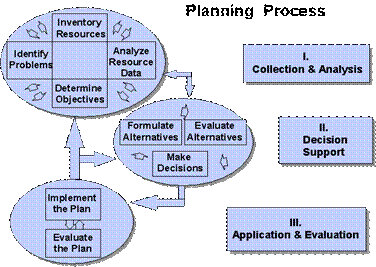Competency Area 9: Conservation Planning AEM
PO 87. Understand the NRCS 9-Step Planning Process and other State planning tools.
The United States Department of Agriculture - Natural Resources Conservation Service (NRCS) developed and uses a three phased - nine-step conservation planning process. It is a systematic, interdisciplinary approach which ensures the integrated use of the natural and social sciences and the environmental design arts in planning and in decision making (See NEPA). The planning process establishes a framework in the spirit of NEPA for planning and applying conservation practices/systems which will " . . .encourage productive and enjoyable harmony between [people and their environment] . . . " (NEPA 1969).
The planning process is presented in the NRCS "National Planning Procedures Handbook (NPPH) available at http://directives.sc.egov.usda.gov/17088.wba . The NPPH provides the following overview of conservation planning:
"Conservation planning is a natural resource problem solving and management process. The process integrates economic, social (cultural resources are included with social), and ecological considerations to meet private and public needs. This approach, which emphasizes desired future conditions, helps improve natural resource management, minimize conflict, and address problems and opportunities. The success of conservation planning and implementation depends on the voluntary participation of clients. While participation is voluntary, NRCS personnel must carry out outreach activities to reach underserved customers, such as minority, and small producers with limited resources, to ensure that services are offered to them on an equal basis with traditional customers. It is imperative that all customers be treated fairly and equitably, with dignity and respect. The planning process used by NRCS is based on the premise that clients will make and implement sound decisions if they understand their resources, natural resource problems and opportunities, and the effects of their decisions.
Conservation planning helps clients, conservationists, and others view the environment as a living system of which humans are an integral part. Conservation planning enables clients and planners to analyze and work with complex natural processes in definable and measurable terms." (NPPH 2003)
|
The NRCS Three Phase – Nine Step Conservation Planning Process
image source: NRCCA Soil and Water Management Study Guide |
|
In New York, the AEM System utilizes a tiered process, consisting of the following five tier distinctions: Tier 1 – Inventory current activities, future plans, and potential environmental concerns. Tier 2 – Document current land stewardship; assess and prioritize areas of concern. Tier 3 – Develop conservation plans addressing concerns and opportunities tailored to farm goals. Tier 4 – Implement plans utilizing available financial, educational and technical assistance. Tier 5 – Evaluate to ensure the protection of the environment and farm viability. (http://www.agmkt.state.ny.us/SoilWater/aem/index.html) Tiers 1 and 2 provide a complimentary series of actions to the NRCS planning process, providing the information to planners in consultation with the landowners, and documenting and prioritizing landowners concerns, needs, and future plans. Tiers 3 through 5 provide a venue for tailoring the plan and for implementation. The interaction of the Nine Step Process and AEM is summarized in Table 1. |
Table 1: AEM and the NRCS Planning Process
Quick Links
- Competency Area 1: Basic soil properties
- Competency Area 2: Soil hydrology AEM
- Competency Area 3: Drainage and irrigation AEM
- Competency Area 4: Soil health and compaction
- Competency Area 5: Soil conservation AEM
- Competency Area 6: Watershed hydrology AEM
- Competency Area 7: Non-point source pollution AEM
- Competency Area 8: Concentrated source pollution AEM
- Competency Area 9: Conservation planning AEM

